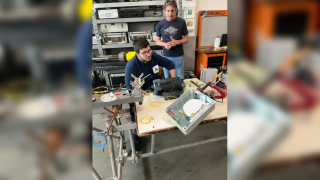Q: What are some of the daily demands of an engineer in a data centre?
A: I generally arrive at the data centre at 7.30am, but if I’m on call I can be contacted by customers at any time of the day or night. I live just round the corner from Interxion’s base in Brick Lane, so it doesn’t take long to get there.
Soon I’ll even be able to sleep in the data centre. To cope with disruption during the London 2012 Olympic Games, Interxion has invested in some sleeping pods so that we can continue to keep things running for our customers whatever happens.
My mornings are generally spent doing cross-connects, connecting customers to one another with fibre or copper. The ‘hubs’ inside our data centres are communities of customers in particular markets (for example financial services or digital media) so they often serve as a platform for collaboration between members with common interests.
I spend four or five hours a day on the phone to customers, troubleshooting on circuits or installing something new for them. If they want to come down in person, they can ‘borrow’ me for the day. I’ll take them around and help them out with whatever they need doing.
Q: And so what are the most satisfying aspects of your job?
A: I love working on technically complex projects, for instance running lots of connections from one fully populated cabinet to the next. It’s a great buzz when you know that they are supporting business-critical applications. A lot of my time is also spent making the data centre run more efficiently, and that can be really satisfying. Customers are increasingly concerned about the carbon footprint of their IT and even small efficiency gains can have a major impact.
Q: How has rising data volumes changed your role at the data centre?
A: With the rise of digital media, my job has got a lot more challenging. Many of these companies are doing new things, so they’re not following a precedent. Also, they often don’t anticipate how quickly they’re going to grow, so it can be a race for the infrastructure to catch up with their needs. We have enough experience to understand what they might look like in a year’s time, so it’s great when customers tap into our expertise to stay ahead.
Q: Finally, what excites you most about working in the industry in the future?
A: I think my job will get easier over the next few years. Interxion has just launched its second London data centre which has been purpose built. That’s not to say I won’t be kept busy though. With data volumes rising and increasing demand for low-latency, high-quality access to data, I imagine I’ll be doing lots of new installs.




